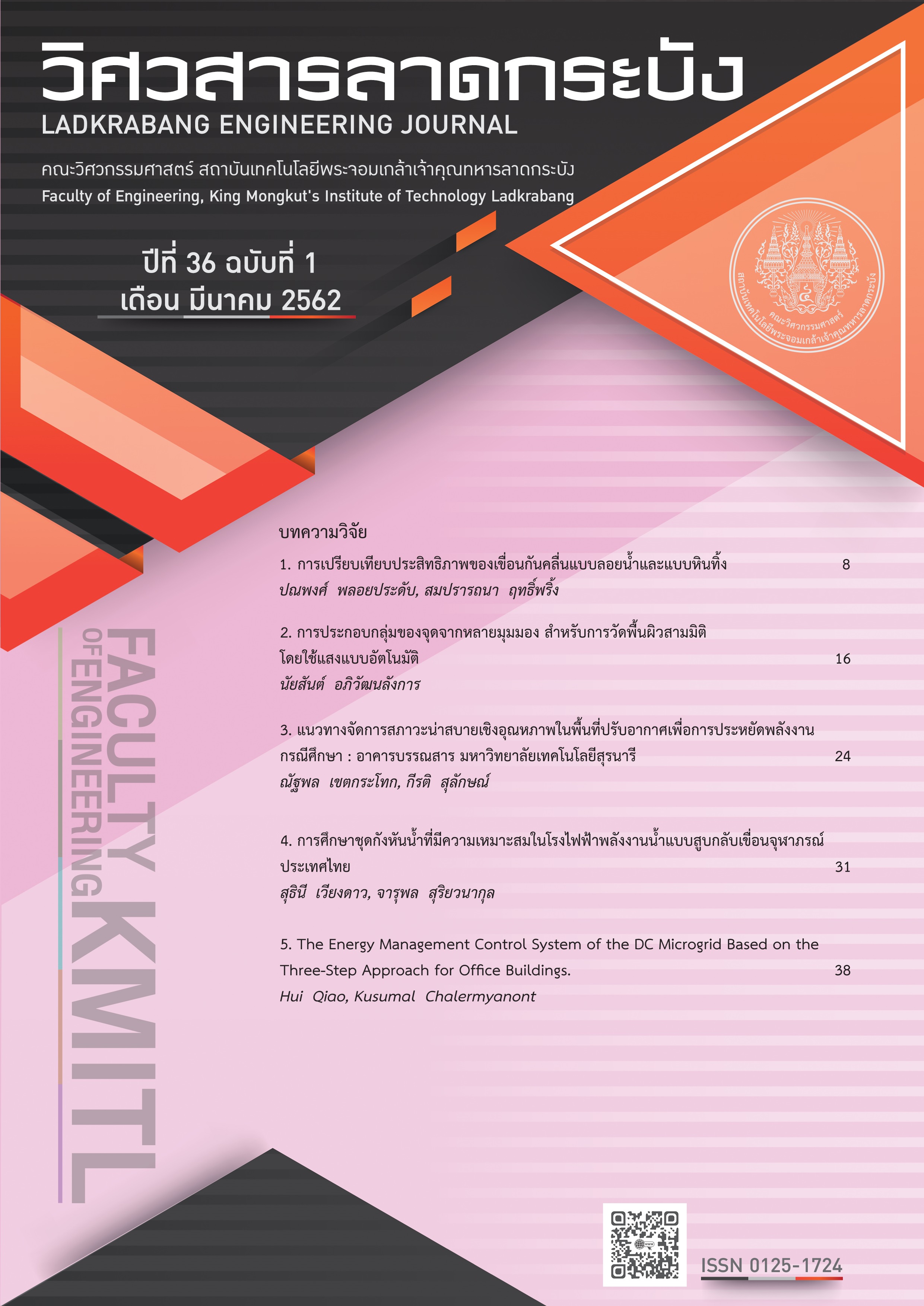Study of Optimal Turbine Set for Pumped Hydro-Storage Power Plant at Chulabhorn Dam, Thailand
Keywords:
Fixed Speed Turbine, Variable Speed Turbine, Hydro Storage Power plantAbstract
This paper presents the study of the optimal turbine set for pumped hydro-storage power plant at Chulabhorn Dam, Thailand. Ten sets of 1,200 MW turbines were investigated with three types of turbines: fixed speed (FIX), variable-speed Doubly Fed Induction Machines (DF), and variable-speed Synchronous Machines Equipped with Full Size Frequency Converter (FULL). The objective to find the best set of turbines with highest efficiency and flexibility was selected for the plant, based on electricity consumption of the Northeast over the past one year. The efficiency and the flexibility are computed from a characteristic curve of each other type of turbine. As a result, the top three sets is set 2 (FULL,FULL, FULL) set 8 (FULL,FULL,DF) and set 9 (DF,DF,FULL), respectively.
References
D. Heide, L. von Bremen, M. Greiner, C. Hoffmann, M. Speckmann, and S. Bofinger, “Seasonal optimal mix of wind and solar power in a future, highly renewable Europe,” Renew. Energy, vol. 35, no. 11, pp. 2483–2489, 2010.
S. Weitemeyer, D. Kleinhans, T. Vogt, and C. Agert, “Integration of Renewable Energy Sources in future power systems: The role of storage,” Renew. Energy, vol. 75, pp. 14–20, 2015.
A. Belderbos and E. Delarue, “Accounting for flexibility in power system planning with renewables,” Int. J. Electr. Power Energy Syst., vol. 71, pp. 33–41, 2015.
W. P. Schill, “Residual load, renewable surplus generation and storage requirements in Germany,” Energy Policy, vol. 73, pp. 65–79, 2014.
E. Erayman, “Need for Adjustable Speed Pump Storage Turbines in the Systems Having Large Capacity of Conventional and Pumped Storage Power Plants: A case study for Turkey,” 2016.
E. Ela, B. Kirby, A. Botterud, C. Milostan, I. Krad, and V. Koritarov, “Role of Pumped Storage Hydro Resources in Electricity Markets and System Operation,” HydroVision Int. Denver, Color. July 23-26, 2013, no. May, pp. 1–12, 2013.
T. Electric, P. Company, T. Electric, and P. Services, “Final Report on Feasibility Study on Adjustable Speed Pumped Storage Generation Technology Japan International Cooperation Agency ( JICA ) Tokyo Electric Power Company Tokyo Electric Power Services,” no. January, 2012.
S. Data and N. Head, “Chapter – 3 hydraulic turbine classification and selection 3.1,” in MODERN HYDROELECTRIC ENGINEERING PRACTICE IN INDIA ELECTRO-MECHANICAL WORKS, 2003, pp. 53–109.
Egat, “Constant Speed & Adjustable Speed Pumped Storage Chulabhorn Power Plant.” [Online].Available: https://nehydro.egat.co.th/dept_maint/images/document/hepco/VSPS_.pdf.
C. Yang, X. Yang, and Y. Chen, “Integration of variable speed hydropower generation and VSC HVDC,” 2015 17th Eur. Conf. Power Electron. Appl. EPE-ECCE Eur. 2015, 2015.
D. Beevers, L. Branchini, V. Orlandini, A. De Pascale, and H. Perez-Blanco, “Pumped hydro storage plants with improved operational flexibility using constant speed Francis runners,” Appl. Energy, vol. 137, pp. 629–637, 2015.
T. Kuwabara, A. Shibuya, H. Furuta, E. Kita, and K. Mitsuhashi, “Design and dynamic response characteristics of 400 MW adjustable speed pumped storage unit for Ohkawachi Power Station,” IEEE Trans. Energy Convers., vol. 11, no. 2, pp. 376–382, 1996.
Phongsakorn.r, “report about water level in dam.” [Online]. Available: https://ichpp.egat.co.th /statusdam_report_internet.php.
TMD, “Meteorological Department.” [Online]. Available: https://www.tmd.go.th/. [Accessed: 25-Feb-2019].
S. Strategy and A. C. Study, “Fuzzy Logic Based Multi-Criteria Wind Turbine Selection Strategy —A Case Study of Qassim, Saudi Arabia,” pp. 1–26, 2016.
R. Mosadeghi, J. Warnken, R. Tomlinson, and H. Mirfenderesk, “Computers , Environment and Urban Systems Comparison of Fuzzy-AHP and AHP in a spatial multi-criteria decision making model for urban land-use planning,” Comput. Environ. Urban Syst., vol. 49, pp. 54–65, 2015.
Downloads
Published
How to Cite
Issue
Section
License
The published articles are copyrighted by the School of Engineering, King Mongkut's Institute of Technology Ladkrabang.
The statements contained in each article in this academic journal are the personal opinions of each author and are not related to King Mongkut's Institute of Technology Ladkrabang and other faculty members in the institute.
Responsibility for all elements of each article belongs to each author; If there are any mistakes, each author is solely responsible for his own articles.






